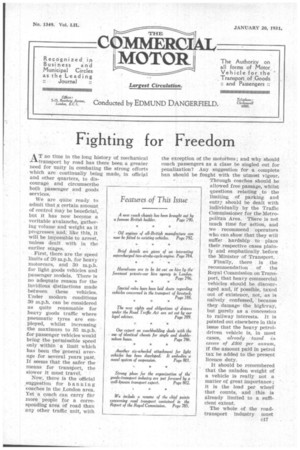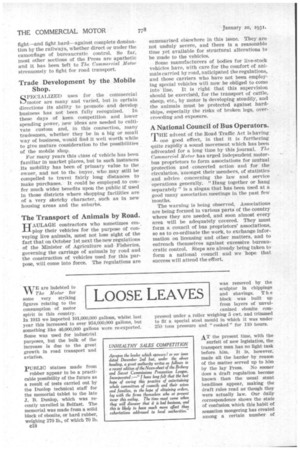Fighting for Freedom
Page 39

Page 40

If you've noticed an error in this article please click here to report it so we can fix it.
.4-3A T no time in the long history of mechanical transport by road has there been a greater need for unity in combating the strong efforts which are continually being made, in official and other quarters, to dis courage and circumscribe both passenger and goods services.
We are quite ready to admit that a certain amount of control may be beneficial, but it has now become a veritable avalanche, gathering volume and weight as it progresses and, like this, it will be impossible to arrest, unless dealt with in the earlier stages.
First, there are the speed limits of 20 m.p.h. for heavy motorcars, and 30 m.p.h. for light goods vehicles and passenger models. There is no adequate reason for the invidious distinctions made between these vehicles. Under modern conditions 30 m.p.h. can be considered as quite reasonable for heavy goods traffic where pneumatic tyres are employed, whilst increasing the maximum to 35 m.p.h. for Passenger vehicles would bring the permissible speed only within a limit which has been the general average for several year's past. If seems that the safer the means for transport, the slower it must travel.
Now, there is the official suggestion for banning coaches in the _London area. Yet a coach can carry far more people for a corresponding area Of road than any other traffic unit, with the exception of the motorbus ; and why should coach passengers as a class be singled out for penalization'? Any suggestion for a complete ban should be fought with the utmost vigour.
Through coaches should be allowed free passage, whilst questions relating , to the limiting . of parking and entry should be dealt with individually by the Traffic -Commissioner for the Metropolitan Area. There' is not much time for action, and we recommend. :operators Who can show; .that.they suffer hardship to place their respective cases plaint ly and emphatically: before the 'Minister of Transport.
• Finally, there is the recommendation of the Roy-al Commission on Transport, that heavy commercial vehicles, should be discouraged and,* if possible, taxed out of existence, not, as is naïvely confessed, because they damage the highway, but purely as a concession to railway interests. It is pointed out elsewhere in this issue that the heavy petroldriven vehicle is, in most cases, already taxed in excess of Z200 per ass1FUM , if the amount paid in petrol tax be added to the present licence duty.
It should be .remembered that the unladen weight of a vehicle is really not a matter of great importance ; It is the load per wheel • that counts, and this is already limited to a sufficient extent.
The whole of the roadtransport industry must fight—and fight hard—against complete domination by the railways, whether direct or under the camouflage of bureaucratic control. So far, most other sections of the Press are apathetic and it has been. left to The Commercial Motor strenuously to fight for road transport.
Trade . Development by the Mobile . Shop. •
SPECIALIZED uses for the commercial motor are many and varied, but in certain directions its ability to promote and develop business has not been fully recognized. In these days of keen competition and lower spending power, new ideas are needed to cultivate custom and, in this connection, many tradesmen, whether they be in a big or small way of business, would find it well worth while to give mature consideration to the possibilities of the mobile shop.
For many years this class of vehicle has been familiar in market places, but in such instances its mobility has been of primary value to the owner, and not to thu buyer, who may still be compelled to travel fairly long distances to make purchases. It could be employed to confer much wider benefits upon the public if used In those districts where shopping facilities are of a very sketchy character, Such as in new housing areas and the suburbs.
The Transport of Animals by Road.
HAULAGE contractors who sometimes em-.. ploy their vehicles for the purpose of conveying live animals, must not lose sight of the fact that on October 1st next the new regulations of the Minister, of Agriculture and Fisheries, governing the carriage of animals by road and the construction of vehicles used for this purpose, will come into force. The regulations are summarized elsewhere in this issue. They are not unduly severe, and there is a reasonable time yet available for structural alterations to be made to the vehicles.
Some manufacturers of bodies for live-stock vehicles have, with care for the comfort of animals carried by road, anticipated the regulations, and those carriers who have not been employing special vehicles will. now be obliged to come into' line. It is right that this supervision should be exercised, for the transport of cattle, sheep, etc., by motor is developing steadily, and the animals must be protected against hardships, especially the risks of broken legs, overcrowding and exposure.
A National Council of Bus Operators.
rr HE advent of the Road Traffic Act is having --Ione good effect, in that it is furthering quite rapidly a sound movement which has been advocated for a long time by this journal. The Commercial Motor has urged independent motorbus proprietors to form associations for mutual protection and concerted action and for the circulation, amongst their members, of statistics and advice concerning the law and service operations generally. "Hang together or hang separately" is a slogan that has been used at a good many association meetings in the past few months.
The warning is being observed. Associations are being formed in various parts of the country where they are needed, and soon almost every area will be adequately covered. They must form a council of bus proprietors' associations, so as to co-ordinate the work, to exchange information on licensing and other matters, and to entrench themselves against excessive bureaucratic control. Steps are already being taken to form a national council and we hope that success will attend the effort.












































































































